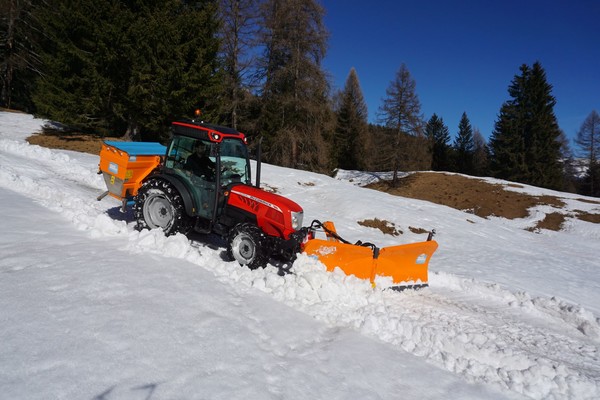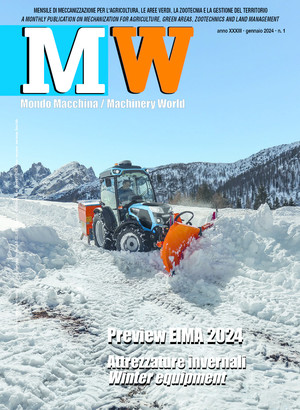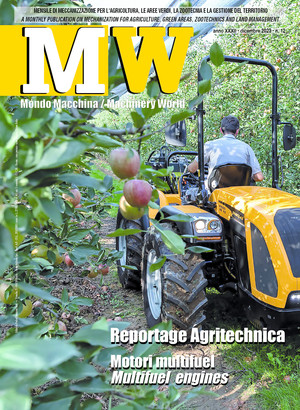
Snowploughs, types and models
With the arrival of the winter season and the first rainfall, the problem of cleaning roads, driveways and pavements from snow arises. For this type of operation, various types of equipment can be used in combination with a tractor. Snowploughs are the best known
The arrival of the winter season, which has finally begun with abundant snowfalls in the Alps, bodes well for a restoration at high altitudes of those reserves accumulated in the form of snow, which will prove to be so precious for agriculture come spring/summer, allowing their melting to feed watercourses and thus irrigate fields. Snowfalls, off the ski slopes and mountain ridges, cause considerable inconvenience, sometimes even more or less serious damage to property and/or persons. The most obvious consequence, however, relates to the inconveniences associated with roads and motorways, as well as rail and air mobility. In order to reduce the risks caused by snowfall, the most prone areas prepare for it by adopting specific management plans that are based on meticulous planning, carried out both in urbanised areas and along road and rail lines, as well as, of course, at airports. Downstream of the planning, however, it is necessary to have an adequate fleet of machinery including snowploughs, snowblowers, salt spreaders and sprayers. Except for operations in restricted areas such as airports, when it comes to large-scale operations it can be very useful for the vehicles to be geo-referenced. By using a now common fleet management system, it is possible for the control centre to know in real time the exact position of each vehicle and quantify the work it has actually done. Those who own that versatile vehicle, the agricultural tractor (which is normally used little or not at all during the winter months), know very well how it is possible to turn the problem of snowfall into an opportunity, simply by equipping it with equipment and accessories that make it suitable for cleaning snow-covered and frozen surfaces. This is a very interesting income opportunity that, among other things, takes place in a time frame in which, also due to the weather pattern associated with snowfall, most agricultural work is impossible. In general, snow clearing is carried out using two types of equipment: snowploughs, which move the snow layer to the sides of the carriageway, and so-called snowploughs, which intercept the layer to be removed by means of a rotor usually equipped with a cutter auger, which conveys the material to a side ejection system. Snowploughs are undoubtedly the most widespread equipment and the most familiar even to the uninitiated. There are many different models on the market with the most varied prices. They range from very simple and small blades that can be attached to small lawn tractors or quads (useful for clearing snow from pavements), which can be purchased at very low prices starting at around 250 euro, to large blades that can even exceed 10,000 euro. In any case, this is equipment that, if used with due care and if constantly maintained, will remain in good condition over time. Two factors must be considered when choosing a snowplough blade: the type of work to be performed and the characteristics of the vehicle with which the blade will be used. In the latter case, the mass and power of the tractor to which the blade will be connected must be carefully evaluated, so as not to risk choosing a blade that is so heavy that it will complicate its use and handling. The dimensions usually range from about 1 to just over 3 metres working width, with heights varying between 50 and 100 cm: smaller models are usually combined with specialised vineyard and orchard tractors or small multi-utility tractors for cleaning pavements and driveways. The type of surface to be cleared also plays a decisive role in the choice, as each type of snowplough is adapted to a specific requirement. In general, they are attached to the front of a vehicle and are made of steel, or more rarely polyethylene, and can be straight or with a 'V' design.
Coupling to the tractor is usually done at the front (unless tractors are equipped with reverse drive) and can be conveniently achieved by using the 3-point hitch (if present), or by using special plates connected to the weight carrier, usually equipped with hydraulic cylinders that allow vertical and transverse movement (to adjust the opening angle with respect to the direction of travel).
It is no coincidence that the snowplough blade is usually paired with accessories to optimise its performance in this aspect: for example, to make it easier to overcome obstacles on the ground (e.g. protruding manhole covers, speed bumps, etc.) it is common to use springs (sometimes adjustable), or alternatively hydraulic cylinders, sometimes equipped with nitrogen shock absorbers. Adjustable slides are used to adjust the working height, usually made of special wear-resistant steel and placed on the sides of the blade so that the weight of the blade itself can also be partially unloaded onto the ground. No less important is the possibility of adjusting the vertical angle of the blade. This operation can be carried out mechanically (on the simplest models) or hydraulically. In the latter case there is the option of continuous adjustment from the driver's seat. The accessories that can be installed on snowploughs also include side deflectors, made of plastic material and useful for removing snow near "New-Jersey" traffic dividers, as well as the ever-present electronic control units dedicated specifically to snowploughs, which automatically manage the various actuators, allowing the operator to work faster and concentrate more on driving. Also among the accessories for snowploughs, it is worth mentioning the working (and clearance) lights, which increasingly adopt modern LED technology.
There are many national manufacturers of snowploughs, and despite the relative simplicity of the product they make, they export a good part of what they produce, contributing significantly to Italy's trade balance. Most of them are based in northern Italy and the various models they produce are certainly capable of satisfying even the most particular and specific needs both in terms of coupling with tractors or other vehicles characterised by highly variable masses, and in terms of completeness of functions and accessories. Without claiming to provide a complete list, some of the best-known names include Assaloni of Bologna (which collaborates both with the neighbouring Orsi Group and with Giletta-Bucher Municipal, the Cuneo-based Giletta that entered the orbit of the French Bucher Municipal in 2002), Angeloni of Montecarotto (AN), Annovi Aldo of Corlo di Formigine (MO), Argnani e Monti of Bertinoro (FC), Autotrasporti Cavallo of Cuneo, BellonMit of Cadoneghe (PD), Bombelli of Segrate (MI), Bonatti Caricatori of Pegognaga (MN), Daniele & Giraudo of Vottignasio (CN) and Faza of Città di Castello (PG).
Attention to exceptional vehicles
For large equipment, as in the case of a tractor equipped with a blade that exceeds a total width of 2.55 m, we must bear in mind that, in order to circulate on public roads, vehicles must have a specific authorisation. This authorisation is issued only on condition that the competent offices (C.P.A. or Motorizzazione Civile) indicate in the vehicle documents "permission to attach, for temporary use, the snowplough". This is due to the fact that the support and the snowplough are not accessories included among those of the mounted or semi-mounted type intended for agricultural work, in which case the agricultural tractor falls under the regulations provided for by art. 38 of Presidential Decree no. 495/92 (Regulations for the execution and implementation of the N.C.d.S.) in execution of art. 21 of Legislative Decree 285/92 (N.C.d.S.), proper to operating machines that carry out industrial-type activities. In this case, it is therefore necessary to update the registration certificate following a specific check with a test carried out by the C.P.A. or the Civil Motor Vehicle Authority. When the tractor is used for snow clearing operations, fuel subsidies cannot be used.
The lower blades
In order to operate quickly, while also preserving the road surface, it is particularly important to be able to adjust the working height with great precision and to allow obstacles to be easily overcome, but the type of material used to make the lower blade, which is the interchangeable component subject to the greatest wear and tear, is also important. The scraper blade must have characteristics such that it is not subject to excessive wear in normal operation, it must also ensure the possibility of operating constantly 1-2 mm from the road surface, it must minimise friction with it in the event of contact, and it must also be able to damage the road surface (and road markings) as little as possible. On the market there are models made of wear-resistant steel, but when the need to preserve the road surface becomes pressing, it is increasingly common to use softer materials, such as high-density synthetic rubbers or highly elastic plastic materials, such as polyurethane or Teflon.








